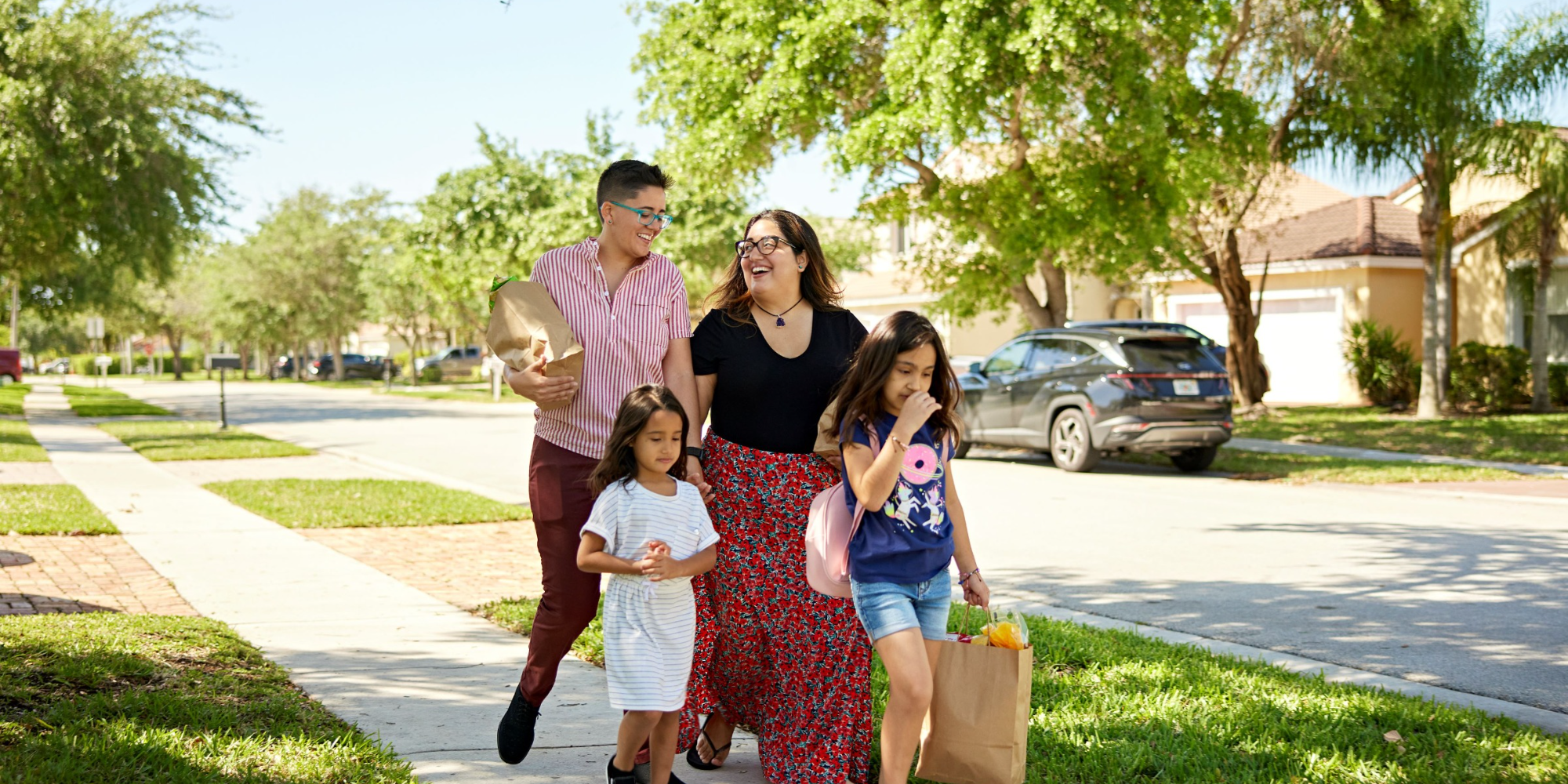What kind of transformative impact would it have on communities if every resident could easily access daily amenities—such as libraries, schools, parks, recreation centers or grocery stores—in less than 20 minutes? As municipal leaders look to strengthen local economies, expand housing and reduce greenhouse gas emissions, they should consider how to utilize an urban planning concept known as the 15-minute city.
A 15-minute city enables residents to access most daily amenities within a 15 to 20-minute walk, bike or other mode of transportation from any point in a city, town or village regardless of size. The concept integrates transportation planning, urban design, mixed-used development, safety on streets and sidewalks, with policy making and the real-life experiences of residents to allow for more freedom of mobility and increased opportunity.
Fifteen-minute cities have received some negative media attention because they were falsely seen as anti-car or be a top-down planning approach. However, in actuality, the 15-minute city concept gives local leaders a lens to integrate all transportation modes and planning tools to create an abundance of opportunities for residents in each neighborhood. Policies that further the 15-minute city concept will vary depending on a municipalities’ needs and goals but can include:
- eliminating food deserts
- expanding government services, especially emergency ones
- supporting neighborhood schools
- reducing carbon emissions
- rezoning street corners or high-traffic areas for commercial and cultural amenities
A working paper from the National Bureau of Economic Research examines data from the 418 most populated urban areas in the U.S. and found that the median U.S. city resident makes 12 percent of their trips from home within a 15-minute walk. This radius could be expanded if municipalities aim for 20- to 30-minute neighborhoods (i.e., 1 to 1.5 miles of walking). Researchers also found a causal link between greater access to amenities and the willingness to walk within a 15-minute radius.
Building out neighborhoods within a 15 to 30-minute radius can bring positive results for municipalities interested in equity, health, climate and economic development. Within the U.S., there is a sizable population that cannot or should not drive, creating demand for non-automobile travel among seniors, youths, adults unable to drive or without a driver’s license and community visitors and tourists. Increasing walking and biking mobility options can help meet the needs of certain populations in this group, lower emissions and increase healthy opportunities for residents through reduced air pollutants. A study from the American Association of State Highway and Transportation Officials (AASHTO) highlights that mobility investments in things like bike infrastructure and sidewalks create more jobs per million dollars spent than other traditional transportation investments.
“The goal of the 15-minute city is to provide convenient and equitable access to necessities like healthcare, schools, grocery stores, jobs, and greenspace,” writes Cleveland, OH, Mayor Justin Bibb’s spokesperson Marie Zickefoose. “Our transportation system and neighborhood configurations currently provide this access to residents with cars, which leaves out almost a quarter of our residents.”
How Municipalities are Building Complete Neighborhoods
As the 15-minute city concept continues to gain prominence, many municipalities have integrated the concept into their planning and design efforts to help accomplish existing goals.
Portland, Oregon
Portland has used the “20-minute neighborhood” as a planning concept since 2010, when the city passed the Portland Climate Action Plan and set a goal that 90 percent of the city “could easily walk or bicycle to meet all basic, daily, non-work needs” by 2030. This design concept furthers two of the city’s major goals: achieving urban equity by ensuring all residents have access to amenities and public space; and reducing greenhouse gas emissions by increasing the share of trips made with transit, walking and bicycling. To accomplish these goals, the city first assessed the walkability and proximity of goods and services in neighborhoods across the city to determine needs. As a result of this assessment, city leaders also have taken a range of actions to move the city closer toward its goal of healthy connected neighborhoods. These actions include expanding pedestrian and bicycle infrastructure and trails, redesigning streets for community use, investing in arts and culture facilities as incubators and building affordable housing in already amenity rich areas to grow the population that can easily access those amenities.
Cedar Rapids, Iowa
Part of Cedar Rapids’ Community Action Plan envisions that by 2030 all core neighborhoods will meet residents’ needs within a 15-minute walk or bike ride. The overarching goal of the plan adopted in 2021 is to reduce carbon emissions by 45 percent by 2030 and be net-zero by 2050. To accomplish their vision of a 15-minute city, Cedar Rapids plans to update their land development regulations to expand missing middle housing and scale commercial opportunities throughout neighborhoods. The city’s Climate Action Plan proposes to create a sustainable development policy that lays out the characteristics, development guidance and incentives to fill in missing amenities found within their 15-minute neighborhoods. Cedar Rapids plans to enhance their transportation options and Complete Street Policy as part of their 15-minute city efforts. All of this work will prioritize vulnerable and under-resourced neighborhoods, including those experiencing excess urban heat and those lacking tree cover.
First Steps to Adopt a 15-Minute City to your City, Town or Village
Consider how the 15-minute city concept applies in your local context. Depending on the geography of amenities and residents in a municipality and its surroundings, the approach toward 15-minute cities may look like any of the following:
- In first-tier suburbs with transit connections to a larger city or metro area, the 15-minute city concept is a complementary approach to transit-oriented development. Creating mixed-use and walkable developments near transit and ensuring pedestrian and bike connections between existing residential areas and transit centers makes cities more livable for current and future residents.
- Small towns with commercial centers or a main street may think about ways to connect residential areas, schools and local business corridors to foster a vibrant community and support local businesses.
- Mid-size and larger cities with many neighborhoods will find varying levels of need throughout the city. In this case, the municipality might start by prioritizing the needs of historically underinvested neighborhoods that are least locally served by essential services.
- Smaller cities’ entire geography may simply fit into a 15-minute radius. For example, all of Auburn, NY, fits within a 15-minute bike radius. Smaller, more affordable municipalities may consider how this planning concept can help attract residents and reduce sprawl. Smaller municipalities in this category may find they have the opportunity to meet all their residents’ needs within their own community.
- Assess the starting place of your city, town or village by mapping the assets and needs across your municipality.
- Connecting neighborhood-level geographic data is essential to assess hyper-local needs. It is important to understand population density and demographics, locations of essential amenities, public spaces, and the quality of walking, biking and public transit networks.
- Set realistic expectations for how the 15-minute city concept can be applied and how it could most benefit your municipality.
- While a 15-minute walking radius for all essential goods and services may be the vision for many cities, others may aim for residents to access daily necessities like grocery stores and schools within a 20-minute walk, while medical services, houses of worship, and offices are accessible within 20 minutes by car or public transit. You may start with setting goals around a specific type of amenity, for example all residents are able to access one green space and one grocery store within a 15-minute walk.
- Determine initial projects that visibly prioritize people-friendly streets. Repurposing a downtown street into a pedestrian-only plaza, hosting an inaugural open streets event, or reclaiming parking spaces for outdoor dining can galvanize public support and raise awareness of this new goal.
- Think about which areas of your municipality are most in need of these changes, and consider starting with a pilot neighborhood.
The next steps will depend on the goals and needs of your municipality. If you’re interested in reading more about the implementation of the 15-minute city, check out C40’s Knowledge Hub on the topic, which includes a tool to explore examples of 15-minute city initiatives.
Bringing It All Together
Municipal leaders looking to expand opportunities for residents or build more complete neighborhoods should consider how the 15-minute city concept can be a useful tool for their city, town or village. Depending on a municipality’s geographic size, needs and layout, there is something for each local government to take away from this concept. While every city, town and village will not be able to achieve an exclusively walkable and bikeable 15-minute city, complete neighborhoods, human-centric design, safety, adding mobility modes, and walkability are important goals for municipalities to consider.









